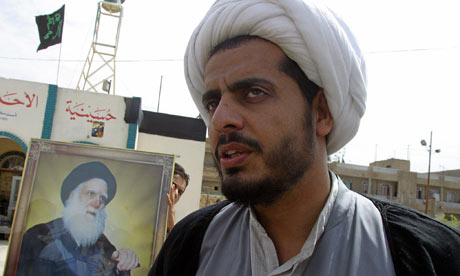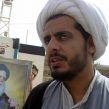
The People of Righteousness: Iraq’s Shi’a Insurgents Issue Demands for Hostages
Publication: Terrorism Monitor Volume: 8 Issue: 6
By:

The second man in the Iraqi Shi’a insurgent group Asa’ib Ahl al-Haq (The People of Righteousness – AAH), Shaykh Akram al-Ka’abi recently gave his first interview to the mainstream pan-Arab media. Al-Ka’abi talked to the London-based magazine al-Majalla, where he revealed that the AAH held two hostages, an American and a Briton, and would not release them without a deal that included the release of AAH prisoners, as well as other conditions (al-Majalla February 2).
A few weeks ago the AAH, which has split from Muqtada al-Sadr’s Jaish al-Mahdi (al-Mahdi Army – JAM), secured the release of its leader Qais al-Khaz’ali, who had been held in an American prison since March 2007 (See Militant Leadership Monitor, January 30). The release of al-Khaz’ali came after the AAH handed over British hostage Peter Moore, who was kidnapped in Baghdad in 2007. Last summer the release of a number of AAH figures coincided with the handover of the bodies of three of the four bodyguards who were kidnapped along with Moore (see Terrorism Monitor, June 25, 2009).
Although both the Iraq and British government denied there was a prisoner exchange deal in the works with the AAH, al-Ka’abi stressed in the interview that there were negotiations with the Iraqi government but not the British. He named Iraqi Shi’a MP Sami al-Askari, an associate to Iraqi Prime Minister Nuri al-Maliki, as the government’s representative.
Al-Ka’abi stated that the remaining British hostage is Alan McMenemy, one of Peter Moore’s four bodyguards. The bodies of the other three were handed over to the Iraqi government last year and passed on to the British embassy in Baghdad. The UK Foreign Office maintains that McMenemy was killed some time ago but is still seeking the return of his body (Telegraph, January 4).
In the interview, al-Ka’abi began by describing the history of the AAH:
"Asa’ib Ahl al-Haq was founded under the name Ahl al-Kahf [The People of the Cave] right after the battle of Najaf in 2004. Muqtada al-Sadr decided then to stop the military operations. But many field commanders wanted to continue with the resistance. Consequently we worked to reorganize our troops independently. Based on the experiences of the battles of 2004 against the Occupier [i.e. the Coalition forces], we changed the tactics of the resistance. Brother Qais al-Khaz’ali and I were in charge of the JAM at that time. I ran the battle in Najaf and he ran the battle in Baghdad. We assigned other commanders in the provinces."
When asked about the relations of the AAH with Iran and its elite Revolutionary Guard, al-Ka’abi answered:
"Iran is a neighboring Islamic country; we respect it and we have good relations with it, especially since The Islamic Republic [of Iran] supports all of the resistance movements, like the Lebanese Hizbollah, the Palestinian Hamas and Islamic Jihad. The Iranian Revolutionary Guard is a group of mujahideen, holy fighters who follow the principles of the Islamic Revolution [i.e. the Iranian Revolution of 1979]. There are many clerics and scholars among them. They have good relations with most of the Iraqi and regional parties."
Al-Ka’abi went on to praise the leader of the Lebanese Shi’a Hezbollah, Hassan Nasrallah. When asked if AAH elements received training in Lebanon, al-Ka’abi apologized, saying that he could not answer due to security reasons.
Al-Ka’abi stressed that the AAH has not killed Iraqis and was not involved in Sunni – Shi’a sectarian violence. Nevertheless, the AAH is criticized by many Sunnis in Iraq as one of the militias involved in sectarian killing. Such accusations have been echoed lately by some Shi’a as well. The AAH is currently trying to deny such accusations. Among the first items placed on the group’s website was a statement denying the allegations:
"Like the other resistance and liberation movements, our resistance was subjected to false accusations by the Occupier’s tools. We did not care about that because we know the sources, the reasons and the goals of such accusations. But what hurts us, and hurts all free resistance members and the honorable Sadrists, is to have such accusations [made] by our brothers and our own people (iraq-moqawama.com, February 2)."
To demonstrate the importance of the AAH in Iraqi resistance operations, Al-Ka’abi listed the most prominent attacks carried out by his group:
• An attack on an American unit in Karbala in 2007.
• An October 10, 2006 attack on the American base Camp Falcon where more than a hundred soldiers were killed, according to al-Ka’abi. The U.S. military reported no casualties in what it described as an explosion in an ammunition dump at the base, but the AAH and rival Sunni insurgent groups argued over who was actually responsible for the explosion (al-Jazeera, October 24, 2009).
• The assassination of an American commander in Najaf (no details provided).
• An attack on a British helicopter in Basra in 2006. Al-Ka’abi claimed that it was brought down by the AAH and five soldiers, including a high-ranking commander, were killed. Al-Ka’abi is probably referring to the May 6, 2006 downing of a British Lynx helicopter by a shoulder-fired surface-to-air missile in the center of Basra. Five British service personnel were killed (BBC, April 27, 2007; UK Ministry of Defence, May 6, 2006; Times, May 8, 2006).
• An attack on the Polish ambassador to Iraq. This was an unsuccessful attempt to abduct Polish Ambassador Edward Pietrzyk on October 3, 2007 that wounded the ambassador and left five dead (al-Jazeera, October 3, 2007).
Al-Ka’abi pointed out that there were many other attacks and many of those are published on the internet. Regarding the kidnapping of the five British hostages, al-Ka’abi denied that they were moved or held in Iran; “Iran has nothing to do with that. The hostages have not been moved out of Iraq at all.”
According to al-Ka’abi, the American hostage is an American military translator of Iraqi descent, Spc. Ahmad Qusay al-Ta’ae, who was kidnapped in Baghdad in 2006. Though there are reports that al-Ta’ae was killed in 2006 by another group and his body transferred to the AAH, al-Ka’abi gave the impression the hostage was still alive (Reuters, February 6).
The AAH also placed a video on its newly-established website of what it described as a captured American officer (Iraq-moqawama.com, February 5). The video appears on the front page of the AAH website beside a copy of al-Majalla’s interview with al-Ka’abi. In the video a man appears in an American army uniform sitting in front of a black banner bearing the name of the AAH unit that has supposedly kidnapped the man – the Imam Ali al-Hadi Battalion. The man was identified as an American officer. Speaking English with a light Middle Eastern accent, the figure urges the American government to respond to the demands of the AAH. The man has since been identified as Issa Salomi, a civilian contractor and translator attached to the U.S. Army who was abducted on January 23. AAH’s demands for the release of the American hostages include:
1- Releasing the resistance prisoners who did not kill Iraqis.
2- Punishing the bodyguards of the American security firm Blackwater (now Xe Services LLC), who are accused of killing Iraqi civilians in 2007, and providing compensation to the families of their victims.
3- The complete withdrawal of all foreign troops in Iraq.
There is still some confusion over which American hostage al-Ka’abi was referring to in his interview, but a few days later an AAH spokesman confirmed that the group was holding two American hostages rather than one (Asharq al-Awsat, February 9). Part of the confusion stems from the AAH practice of still referring to dead captives as “hostages.”
The Iraqi government was clearly upset with the latest abduction. Sami al-Askari, the government negotiator with the AAH, said, “There was a truce with the AAH and the government helped them by releasing some of their detainees. But with the recent abduction they have broken the truce. Therefore we cannot release any more detainees” (Asharq al-Awsat, February 9).






